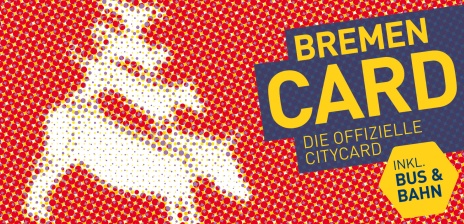Bremen Tourismus: Urlaub in der Hansestadt
Die Bremer Stadtmusikanten sind nicht nur weltbekannt. Ihr guter Plan, nach Bremen zu gehen, ist auch heute noch eine richtig gute Idee. Bremen fasziniert mit urbaner Vielfalt, gelebter Toleranz und lebendiger Kultur. Wir empfangen euch mit Kunst, Musik und Erlebnis, mit Genuss- und Wissenswelten, mit historischem Welterbe und vor allem – mit offenen Armen!
Inspiration für euren Städtetrip
Bremen ist zu jeder Jahreszeit eine Reise wert: Das pulsierende Herz Nordwestdeutschlands erwartet euch mit zahlreichen Sehenswürdigkeiten, kulinarischen und kulturellen Genüssen, hanseatischer Lebensart sowie zahlreichen Gelegenheiten zum Shoppen und vielerlei abwechslungsreichen Aktivitäten. Damit ihr bestens auf eure Reise nach Bremen vorbereitet seid, findet ihr hier Tipps und Inspiration.

Urlaub in Bremen online buchen
Ob Erlebnisse, Hotels oder Pauschalen - wir haben das passende Angebot für euch.
© WFB / Jonas Ginter
Tipps rund um die Reiseplanung
Lasst euch vom aufkommenden Fernweh mitreißen, plant eure Reise nach Bremen und erlebt die Hansestadt live und in Farbe. Unsere Stornobedingungen haben wir für euch gelockert, so dass ihr ganz ohne Risiko eure Reise und die dazu passenden Erlebnisse buchen könnt. Pauschalreisen sind immer bis acht Tage vor Anreise kostenlos stornierbar. Unsere Stadtführungen sind bis einen Tag vor Anreise kostenlos stornierbar und viele Hotels bieten dies sowieso bis zum Anreisetag. Also los geht's: Plant eure Reise nach Bremen!
Beratung und Wissenswertes von den Bremen-Profis
Wünscht ihr euch eine persönliche Beratung für eure Reise nach oder euren Aufenthalt in Bremen? Seid ihr auf der Suche nach konkreten oder inspirierenden Tipps? Dann sind die Bremen-Profis für euch da. Ob im Gespräch oder mit unterschiedlichen Publikationen - hier seid ihr immer gut beraten!

Entdeckt mit der AR-App BremenGo die Bremer Altstadt!
Die Stadtmusikanten werden zu euren persönlichen Tourguides.
© WFB / Radiusmedia KG / Jonas Ginter


